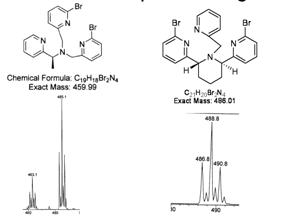AmericanChemicalSociety.com
Reports: UNI1 49354-UNI1: Enantiospecific Hydroxylation of Alkanes Catalyzed by Transitional Metal Complexes of Chiral Tripodal Ligands Based on Tris(2-pyridylmethyl)amine
Zhaohua Dai, PhD, Pace University
Aim:
We proposed to develop chiral-TPA derivatives based catalytic systems that can transform aliphatic C-H bonds into chiral alcohols with high enantioselectivity using the environmentally friendly oxidant H2O2. To arrange the pyridyl arms of TPA into propeller-like chiral configuration in FeII complexes and put the reactive intermediate FeV=O in a chiral bias, we proposed that a methylene proton in TPA was to be substituted with a methyl group to chiral podands; in second generation catalysts, a rigidified piperidine ring was to be incorporated by connecting the two chiral arms; further rigidified ligands could incorporate a second ring, resulting in chiral quinuclidine structures. The original design is shown in Figure 1.
Figure 1. Original design of rigidified chiral scaffolds.
Current Status:
A. Syntheses:
The P.I. and his undergraduate research assistants have successfully obtained many of the proposed chiral podand, pipredine and quinuclidine ligands. The proposed podand ligands S-(a)-MeBr2TPA was obtained by Jenifer Li, with the help from Steven Lopez, following published protocols. The piperidine and quinuclidine ligands were obtained by Pace undergraduates Patrick Carney and Amanda Mickley with the help from Maykel Khilla, Christine Toledo and high school student Kirill Grinberg. The structures and mass spectra (ESI) of the podand and piperridine ligand is shown in Figure 2. The absolute configuration obtained matched what was expected from asymmetric synthesis and the e.e. was determined by chiral HPLC to be >99%. The NMR and mass spectra and chiral HPLC chromatogaph of the quinuclidine ligand is shown in Figure 3.
Figure 2. Structrue and ESI mass spectra of the synthesized chiral podand (left) and piperidine (right) ligands.
Figure 3. ESI mass spectrum, NMR and chiral HPLC analysis of the synthesized chiral quinuclidine ligand 7.
B. Attempt to obtain Fe(II) complexes of the above lignads
LCMS showed the these chiral lignand can form complexes with Fe(II). However, no crystals suitable for crystallographic analysis has been obtained through recrystallization, although we did obtained X-ray quality crystal for some non-chiral TPA-Fe(II) complexes. We will try other protocols to obtained crystals for X-ray analysis.
C. Catalysis (Future Work)
We will investigate the catalytic properties of the metal complexes of these ligands as proposed in the following year.
Impact
I had been trying to stimulate students' interest in chemistry through research projects in contemporary issues as described in this proposal. However, due to the high cost of living in New York City, it was hard to recruit Pace undergraduates who are from financially distressed families in the City and who are not from the Tri-state region in the summer. With this grant and other grants, several students are convinced of the scientific rigor of my research and my research assistants get some stipend in the summer. Since then, quite a number of students joined my group, which helps me develop a stable, sustainable and more diverse research work force, advancing the research program at Pace and my own career in academia. Together with my excellence in teaching, service and research, especially research supported by external grants like this grant, I was granted tenure this September.
Successful completions of the different stages of the project gives my students a strong sense of achievement, leading to careers in the discipline of chemistry. Ten students have worked on my research projects and they do pursue careers in chemistry. Michael Isaacman, Stacy-Ann Collins and Cho Tan are in Ph.D programs in chemistry and biochemistry. This September, several students worked on this project just started their new life in graduate school. Steven Lopez went to UCLA for doctoral study in Chemistry. Amanda Mickley went to graduate school for biochemistry and Patrick Carney is getting a Master's degree in forensic chemistry. Jenifer Lee was a psychology major and she decided to pursue career in natural science fields. Maykel Khilla and Christine Toledo expressed their wishes to pursue graduate degrees in chemistry related fields.Many of our forensic science graduates go on to work as forensic chemists. Kirill Grinberg, a Midwood High School student who is working in my lab, expressed his intention to study chemistry in college.
Copyright © American Chemical Society





